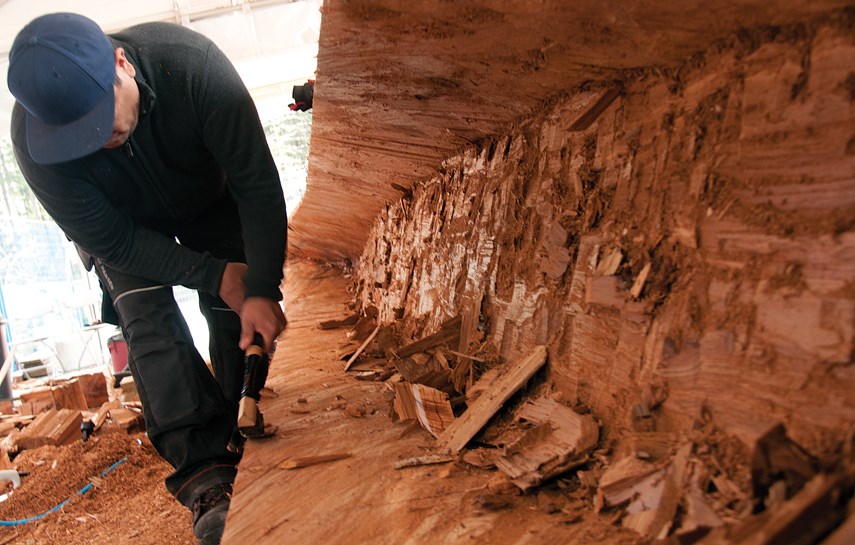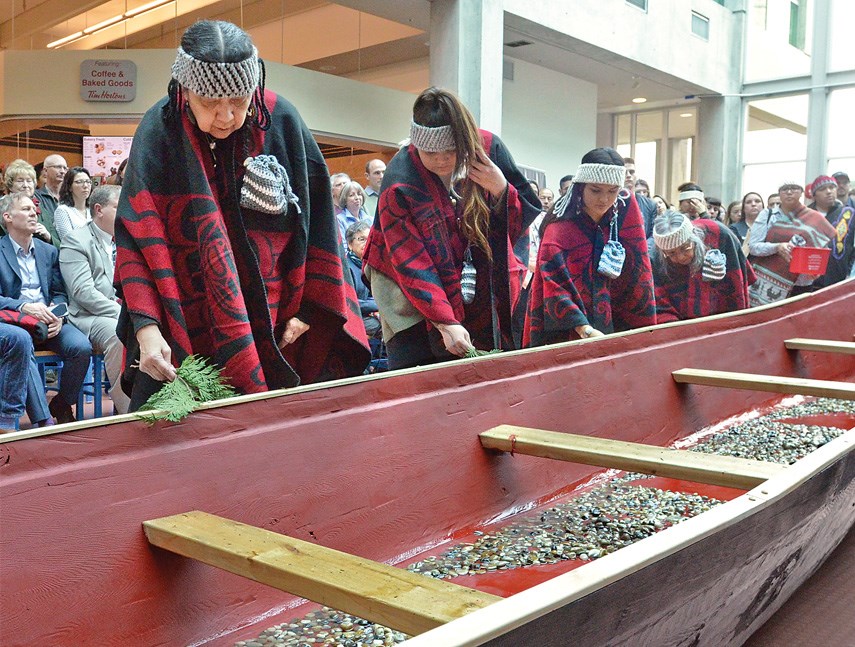Rainy skies and choppy waters weren’t enough to stop the launching ceremony of Capilano University’s Legacy Canoe.
The ceremony was postponed in March when the COVID-19 pandemic hit. Launching the canoe, named Skw’cháys, this month was symbolic of having the strength to move forward in “troubled waters,” explained Joel Cardinal, community engagement facilitator for the university.
After months of being on display, Skw’cháys was brushed off with cedar bows and brought to life in a traditional Coast Salish ceremony before taking its first journey in the water on Friday, Oct. 23.
The 30-foot seaworthy hunting canoe was launched in the rain at Whey-ah-Wichen, Cates Park, as university staff, students and members of Squamish and Tsleil-Waututh nations watched on – under the gazing eyes of two eagles high up on a nearby perch.
Before entering the sea, First Nations members called on the spirits for protection to ensure that moving forward their journeys would be safe and whoever was riding in the canoe would be protected. Up to 10 people took turns riding in Skw’cháys after the traditional ceremony.
It’s been a couple of years since the university first commissioned Squamish Nation master carver Ses Siyam – Ray Natraoro (formerly Natrall) – to create the canoe to mark the university’s 50th anniversary.
Painted in the traditional Squamish Nation colours of black and red, the canoe symbolizes the university’s commitment to Truth and Reconciliation and recognizes the importance of passing on Indigenous knowledge and traditions. Its purpose is to help bring back the culture, language and teachings of the five First Nations whose land the university has built campuses on.
Cardinal said he believed it would be important and symbolic to launch the canoe this term to be “reflective of the journey new students are going on.”
He said switching to a virtual learning environment had resulted in a disconnect for some Indigenous students who greatly benefitted from personal interaction and in-class learning.
“While we normally wouldn’t have launched so late in the season, we thought it was important to show students that we were going to push through and do this as a gesture and a sign of support that we’re also going to continue moving things forward in a good way, no matter how troubled the waters are,” he explained, noting the wet weather didn’t dampen any spirits at the ceremony.
Skw’cháys had already been on quite the journey prior to Friday’s ceremony.
Before the canoe ever touches the water, it goes through a series of ceremonies, starting with a blessing of the chosen log before carving can begin.
Ses Siyam and his apprentices carved the traditional Coast Salish canoe from an 800-year-old red cedar tree from Squamish’s Elaho Valley at the university’s North Shore campus, from February to March last year.
A seventh-generation carver, a hereditary chief and also one of only a handful of Squamish Nation members who still has the knowledge to build a traditional dugout canoe, Ses Siyam said carving at the campus offered him the chance to share his knowledge and gave students, employees and the community the rare opportunity to see the transformation from tree to canoe.
“You can’t learn canoe carving from a book, it’s taught in the oral tradition,” the master carver said, in an article posted by the university.

“This is the most community engagement I’ve ever had carving a canoe and I’m glad it was documented. It’s a great opportunity to leave a legacy and bring cultural awareness to many different audiences.”
In April last year, once the canoe was complete, the university hosted a traditional awakening and naming ceremony, where the spirit of the canoe was awakened after being taken when the log was cut down.
Cardinal said, in this case, the spirit was male, and he was given the name Skw’cháys.
The name was chosen by Ses Siyam who was inspired by a Squamish Nation story from his youth about a hunter who was blessed with a supernatural spear but becomes too “full of himself,” thinking he could catch a great sea lion. “Skw’cháys” is the name of the whirlpool that leads to the underwater world of the sea lion people, a university article explains.
“The name is a reminder that we must always be humble and kind, no matter what gifts we possess,” the article states.

While Skw’cháys will be on display in the learning commons, it isn’t just for show, Cardinal said the canoe would be used for cultural lessons on land and in the water – with ideas to use it in the University One for Aboriginal Learners program and the Squamish, Sechelt or Lil’wat Nation Language and Culture programs offered by the campus.
“We want to make sure we foster the opportunities for cultural connection with our students, so that they’re really grounded in something that showcases pride in who we are as Indigenous people, rather than shame,” said Cardinal, who is Cree.
“How I bring that to the university is showing a lot of pride in this local First Nations’ cultural activities that we are embracing openly.”
He said Indigenous knowledge was being shared throughout the entire Legacy Canoe process.
“By creating these opportunities, the university is privileging traditional knowledge in a way that we haven’t really seen over the years and over the decades,” Cardinal said.
The canoe will offer opportunities for not only students but also university employees and the community to engage and learn Coast Salish culture.
“From there comes compassion and a lot more understanding of our histories and how different things at residential schools have impacted us,” Cardinal explained.
“What we’ve done so far has already shifted the awareness of this institution to be more understanding.”
Elisia Seeber is the North Shore News’ Indigenous and civic affairs reporter. This reporting beat is made possible by the Local Journalism Initiative.


